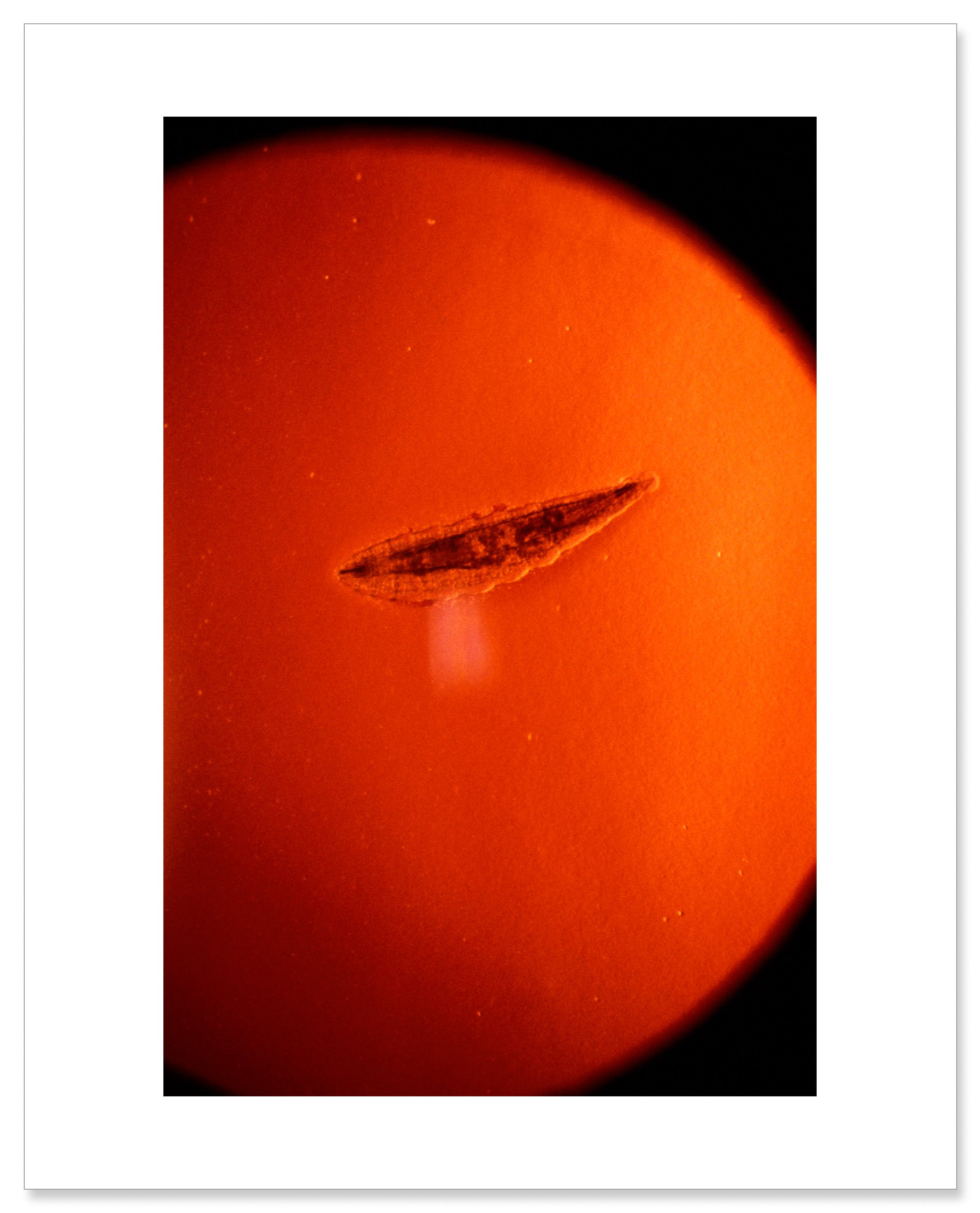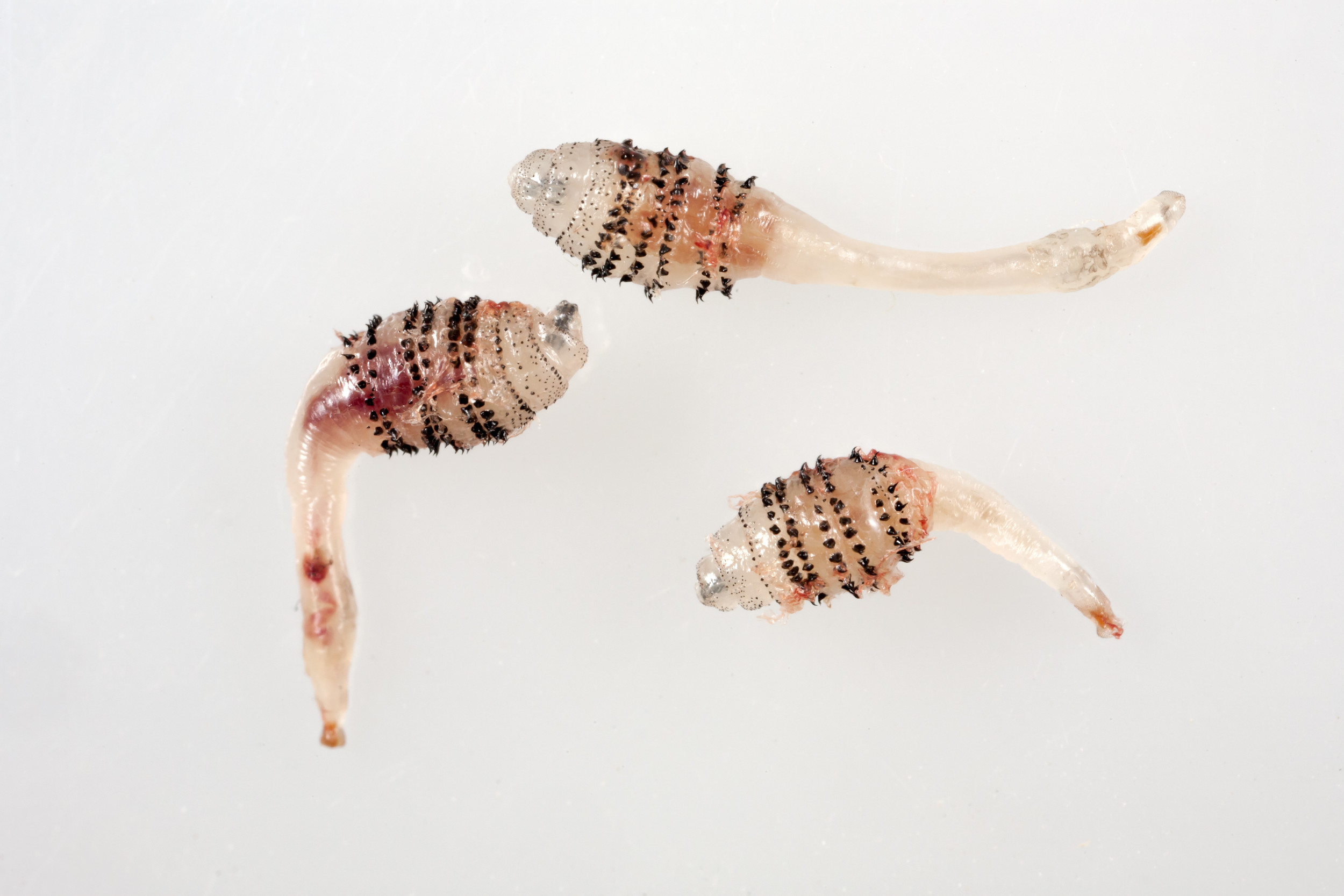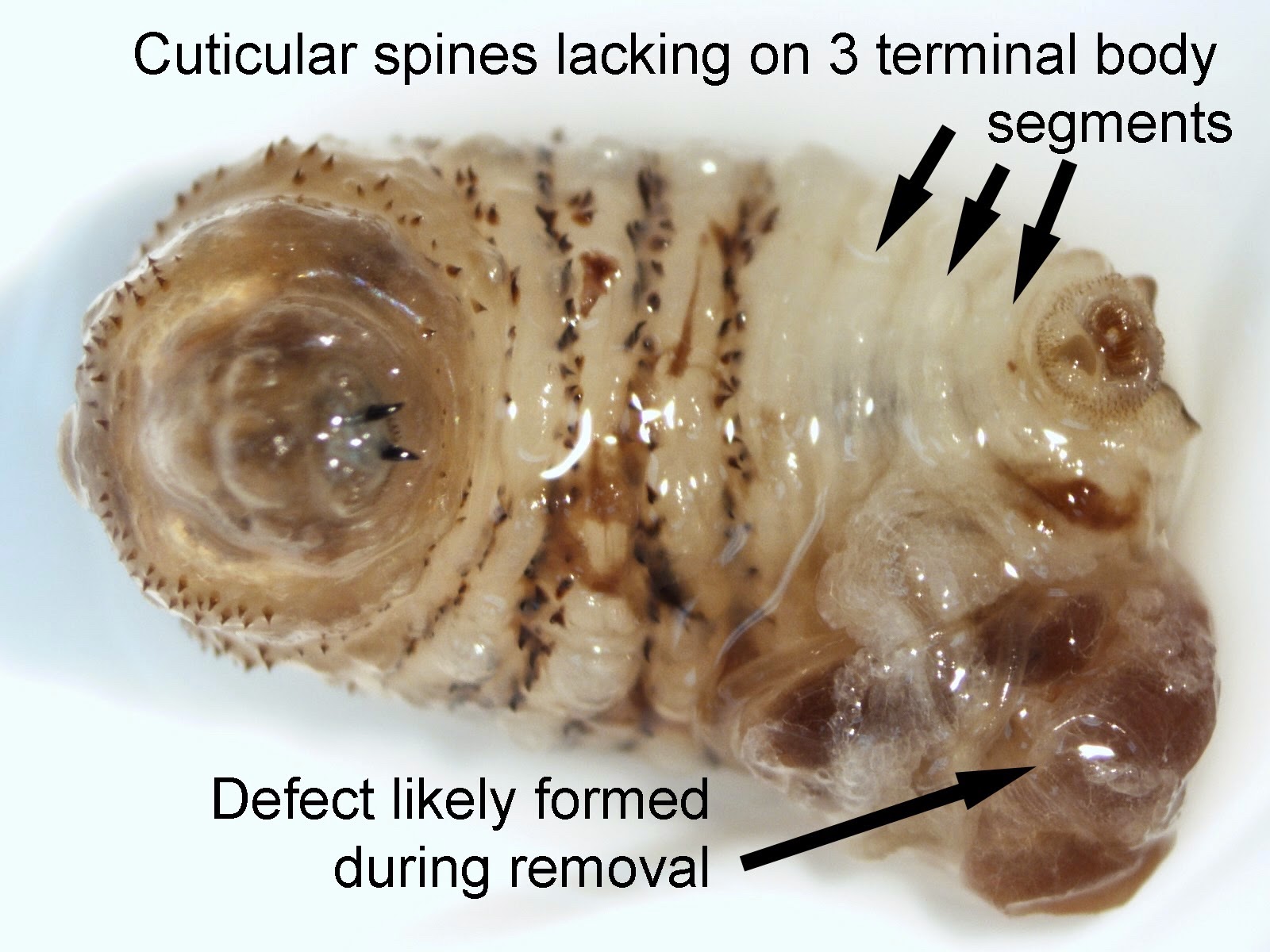Bot Fly Larvae: The Creepy Parasite You Need To Know About
Have you ever heard of bot fly larvae? If not, buckle up because we're diving deep into the world of these tiny but terrifying creatures. Bot fly larvae are one of nature's most fascinating yet horrifying parasites, capable of causing discomfort and even health issues in both humans and animals. Understanding them is crucial, especially if you're into outdoor adventures or work closely with animals.
Picture this: you're enjoying a peaceful hike in the woods when suddenly you notice a strange lump on your skin. At first, you think it's just a bug bite, but as days go by, it starts to swell and itch like crazy. What you might not realize is that you could be hosting an unwelcome guest—a bot fly larva. These critters aren't just creepy; they can cause real problems if left untreated.
Don't panic just yet! While bot fly larvae may sound like something out of a horror movie, there's plenty you can do to protect yourself. In this article, we'll break down everything you need to know about these parasites, from their life cycle to prevention tips. So, let's get started!
- Indian Web Series Bold Trending Titles You Cant Miss
- Stream Now Bengali Movies Web Series More Entertainment
What Are Bot Fly Larvae?
Bot fly larvae, also known as Dermatobia hominis, are the immature stage of the bot fly, a type of parasitic insect found primarily in Central and South America. These little monsters have earned a notorious reputation for burrowing into the skin of mammals, including humans, to complete their life cycle. They’re not your average housefly—they’re far more sinister.
Here’s the deal: adult bot flies don’t bite or sting. Instead, they lay eggs on other insects like mosquitoes or ticks, which then carry the eggs to a host. Once the eggs hatch, the larvae penetrate the host's skin, creating a cozy little home for themselves. Gross, right?
How Do Bot Fly Larvae Infect Humans?
Now, you might be wondering how exactly these larvae end up inside humans. Well, it’s all about the eggs. Adult bot flies cleverly attach their eggs to smaller insects, such as mosquitoes. When these insects land on a human or animal, the heat from the body triggers the eggs to hatch. The newly hatched larvae then burrow into the skin, setting up shop in what’s called a "warble"—a small lump where they feed and grow.
- Indian Adult Movies Watch Free Xxx Videos Films Now
- Ullu Web Series New Releases Trending Shows To Watch Now
It’s worth noting that bot fly larvae aren’t picky eaters. They’ll happily munch on the tissue and bodily fluids of their host, causing discomfort and potential infection. Yikes!
The Life Cycle of Bot Fly Larvae
Understanding the life cycle of bot fly larvae is key to recognizing the threat they pose. Here’s a quick rundown:
- Egg Stage: Adult bot flies lay eggs on other insects, which act as transporters to a host.
- Larval Stage: Once the eggs hatch, the larvae burrow into the host's skin and begin feeding.
- Pupation: After about eight weeks, the larvae drop out of the skin and pupate in the soil.
- Adult Fly: Finally, the pupa transforms into an adult bot fly, ready to start the cycle all over again.
As you can see, the life cycle of bot fly larvae is both fascinating and horrifying. But don’t worry—we’ll cover ways to prevent this cycle from affecting you later on.
Signs and Symptoms of Bot Fly Infestation
So, how do you know if you’ve got a bot fly larva living rent-free in your skin? Look out for these common signs:
- A raised, red lump on the skin
- Intense itching or pain around the lump
- A small hole or opening in the lump where the larva breathes
- Pus or discharge from the lump
While these symptoms might sound alarming, they’re actually your body’s way of trying to fight off the intruder. If you notice any of these signs, it’s important to seek medical attention promptly.
Can Bot Fly Larvae Be Dangerous?
For the most part, bot fly larvae aren’t life-threatening. However, they can cause significant discomfort and, in some cases, lead to secondary infections. If the larva isn’t removed properly, it can result in complications such as abscesses or skin infections. That’s why it’s crucial to have a professional handle the removal process.
How to Remove Bot Fly Larvae
Removing a bot fly larva isn’t something you should attempt on your own unless you know what you’re doing. Here’s a step-by-step guide on how it’s typically done:
- Cover the lump with petroleum jelly or another thick substance to block the larva’s air supply.
- Wait for the larva to move closer to the surface in search of air.
- Use sterilized tweezers to gently extract the larva.
- Clean the area thoroughly with antiseptic to prevent infection.
Again, it’s highly recommended to seek professional help for this procedure. A doctor can ensure the larva is removed completely and safely.
What Happens If You Don’t Remove the Larva?
If left untreated, the larva will eventually leave the host’s body on its own. However, this process can take weeks and may lead to increased discomfort and the risk of infection. Plus, who wants to walk around with a parasite living in their skin? Not me!
Preventing Bot Fly Infestations
Prevention is always better than cure, especially when it comes to bot fly larvae. Here are some tips to keep these pesky parasites at bay:
- Wear protective clothing, such as long sleeves and pants, when in areas where bot flies are common.
- Use insect repellent to keep mosquitoes and other potential carriers away.
- Avoid leaving clothes outside, as bot flies may lay eggs on them.
- Regularly check your skin for any unusual lumps or bumps.
By taking these precautions, you can significantly reduce your chances of encountering a bot fly larva.
Common Myths About Bot Fly Larvae
There’s a lot of misinformation floating around about bot fly larvae. Let’s debunk a few of the most common myths:
- Myth: Bot fly larvae can survive anywhere.
Fact: These larvae are primarily found in tropical regions and thrive in warm, humid environments. - Myth: You can suffocate the larva by covering it with glue.
Fact: While covering the lump can encourage the larva to move, using glue is not a safe or effective method. - Myth: Bot fly larvae are a sign of poor hygiene.
Fact: Anyone can become infected, regardless of their hygiene habits.
It’s important to rely on factual information when dealing with bot fly larvae. Misinformation can lead to unnecessary panic or improper treatment.
Where Are Bot Fly Larvae Most Commonly Found?
Bot fly larvae are predominantly found in Central and South America, where the climate is perfect for their life cycle. However, cases have been reported in other parts of the world, particularly among travelers returning from affected areas.
Bot Fly Larvae in Animals
Humans aren’t the only ones who suffer from bot fly infestations. These larvae are also a major problem for livestock and pets. In fact, they’re one of the leading causes of economic loss in the cattle industry due to damage to hides and decreased productivity.
Here’s how bot fly larvae affect animals:
- They create painful warbles in the skin, leading to discomfort and reduced mobility.
- Infected animals may experience weight loss and decreased milk production.
- In severe cases, untreated infestations can lead to death.
Preventive measures, such as regular inspections and insecticide treatments, are essential for protecting livestock and pets from bot fly larvae.
How to Protect Your Pets
If you have pets, especially those that spend a lot of time outdoors, it’s important to keep an eye out for signs of bot fly infestation. Regular grooming and skin checks can help catch any issues early on. Additionally, consult your veterinarian about preventive treatments to keep your furry friends safe.
Conclusion: Stay Safe from Bot Fly Larvae
Bot fly larvae may be creepy, but they’re not unbeatable. By understanding their life cycle, recognizing the signs of infestation, and taking preventive measures, you can protect yourself and your loved ones from these parasitic pests.
So, the next time you’re planning a trip to a tropical destination, remember to pack your insect repellent and protective gear. And if you suspect you’ve encountered a bot fly larva, don’t hesitate to seek medical attention.
We’d love to hear your thoughts! Have you ever dealt with a bot fly larva? Share your experience in the comments below, and don’t forget to share this article with your friends and family to keep them informed. Stay safe out there!
Table of Contents
How Do Bot Fly Larvae Infect Humans?
The Life Cycle of Bot Fly Larvae
Signs and Symptoms of Bot Fly Infestation
Can Bot Fly Larvae Be Dangerous?
Preventing Bot Fly Infestations
Common Myths About Bot Fly Larvae
Where Are Bot Fly Larvae Most Commonly Found?



Detail Author:
- Name : Athena Rodriguez
- Username : heathcote.catalina
- Email : kaley35@mosciski.com
- Birthdate : 1987-06-19
- Address : 191 Titus Points Emmiestad, WY 85818-7389
- Phone : +1-806-739-3690
- Company : Berge, O'Reilly and Padberg
- Job : Curator
- Bio : Cumque est natus ut enim modi. Culpa qui corrupti maiores ducimus. Optio nesciunt saepe sequi enim. Voluptas at dignissimos molestiae asperiores dolore molestias doloremque.
Socials
facebook:
- url : https://facebook.com/nickfadel
- username : nickfadel
- bio : Veritatis distinctio autem nulla. Ab et dolorum facilis id iure.
- followers : 4244
- following : 1653
instagram:
- url : https://instagram.com/nick_fadel
- username : nick_fadel
- bio : Voluptas ipsa non dolor et commodi modi sit. A qui expedita rerum quidem veritatis.
- followers : 1022
- following : 2228
tiktok:
- url : https://tiktok.com/@nick_fadel
- username : nick_fadel
- bio : Repudiandae quidem adipisci sit aut voluptas praesentium.
- followers : 6150
- following : 14